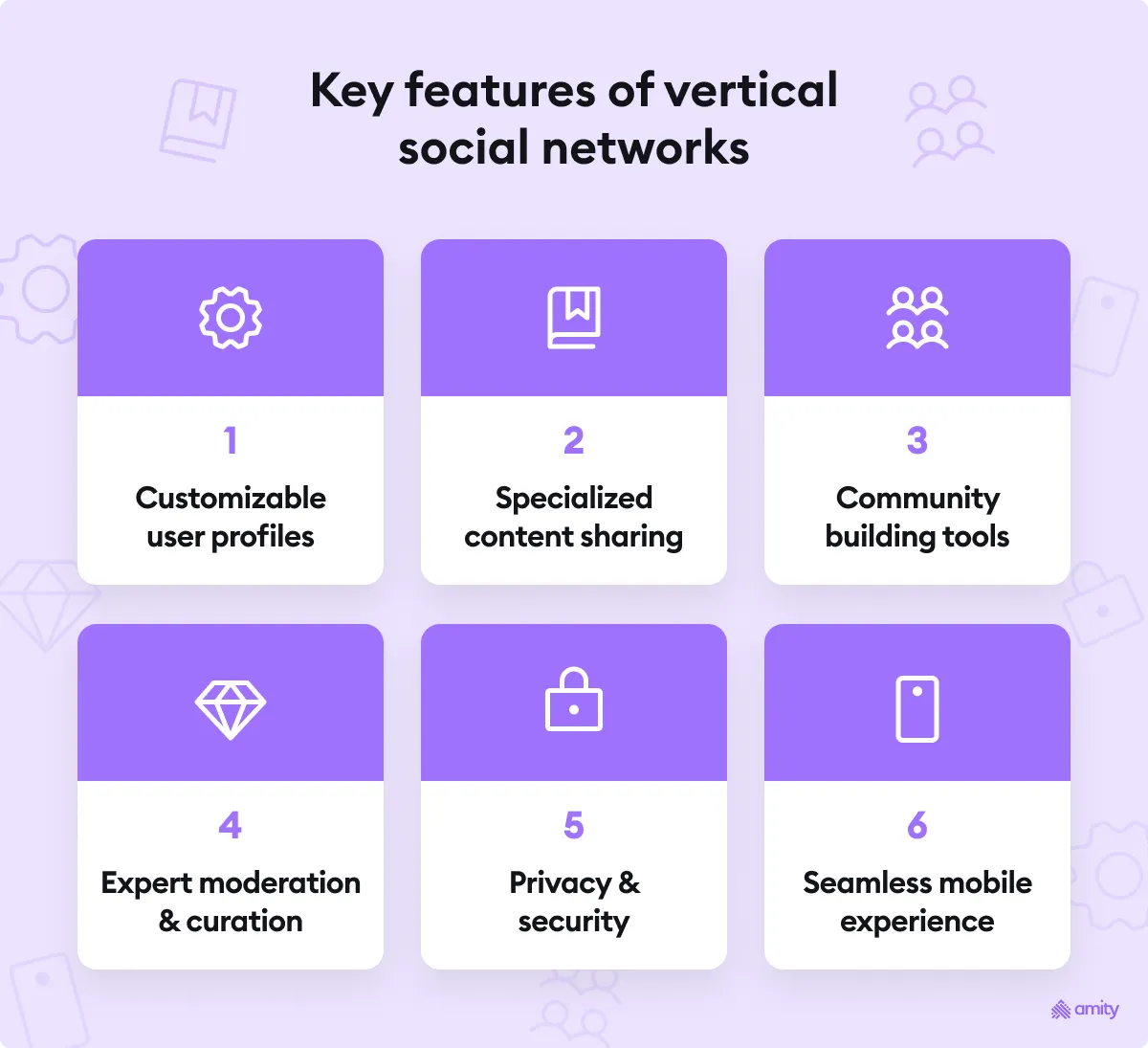With billions of users actively engaging online every day, brands have more opportunities to connect with their target audience. And while traditional networks continue to dominate the social media scene, a new trend has emerged, captivating the attention of both brands and users alike: vertical social networks.
The rise of social media has revolutionized the way individuals interact, share information, and consume content. Platforms like Facebook, Twitter, and Instagram have become household names, offering a diverse range of features and capabilities.
However, as the social media landscape continues to evolve, so do the preferences and needs of users. Enter vertical social networks – a rising phenomenon that is reshaping the digital sphere. There are even claims that “the next $1B consumer startup will be a vertical social network”, and by the end of this article, we hope you’ll see why.
So, what exactly are vertical social networks, and how do they differ from traditional social networks?
What are vertical social networks?
Vertical social networks, also known as niche or specialized social networks, are online platforms that focus on specific industries, interests, or communities.
Unlike traditional social media platforms that cover a wide range of topics and cater to a broad audience, vertical social networks carve out a distinct niche for themselves. They foster a sense of belonging and connection among individuals who share a common passion, hobby, or profession.
By creating a dedicated space for users to engage with like-minded individuals, vertical social networks offer a unique and immersive experience that transcends the limitations of traditional social media.
The allure of vertical social networks lies in their ability to deliver highly relevant and specialized content. Users can dive deep into their specific interests, accessing a wealth of information, discussions, and resources that cater specifically to their niche.
Whether it's a vertical social network centered around fitness enthusiasts, food lovers, or photography aficionados, these platforms provide a curated environment where users can explore, learn, and connect with others who share their passion.
The benefits of vertical social networks
By creating a vertical social network within their app, brands can foster a sense of community, encourage active engagement, and establish themselves as thought leaders within their industry. Vertical social networks provide an avenue for brands to strengthen their relationships with customers, build brand loyalty, and gain a competitive edge in their respective markets.

In the following sections of this article, we will delve into the intricacies of vertical social networks, giving you a comprehensive understanding of how vertical social networks can transform your brand's digital presence.
Targeted marketing: By tapping into a specific niche, a vertical social network allows brands to target their ideal audience more effectively. This enables precise marketing strategies and increases the chances of reaching users who are genuinely interested in their products or services. In addition, you can create efficient digital PR campaigns to boost your brand's visibility and engagement even more.
Community building: Vertical social networks facilitate the formation of vibrant communities centered around shared interests. Users can connect with like-minded individuals, seek advice, share experiences, and find inspiration within a niche community. This strong sense of community fosters loyalty, engagement, and long-term user retention.
User engagement & retention: Vertical social networks offer a more specialized and curated experience for users, leading to enhanced engagement. Users are more likely to spend quality time on these platforms as they find content and discussions directly relevant to their interests, resulting in higher user retention rates.
Increased brand loyalty: Vertical social networks provide a platform for brands to build a loyal community around their offerings. By fostering engagement and providing valuable content, brands can cultivate strong relationships with their customers, leading to increased brand loyalty and advocacy.
Valuable customer insights: A vertical social network allows brands to gain in-depth insights into their target audience. By actively participating in discussions and monitoring user behavior, brands can gather valuable feedback, preferences, and trends, helping them refine their marketing strategies, develop personalized campaigns, and deliver tailored experiences. Vertical social networks can offer deeper and more specific data compared to broader social networks, helping brands make data-driven decisions that resonate with their target audience.
Building thought leadership: Creating a vertical social network within your app allows you to position your brand as a thought leader within your niche. By providing a platform where users can interact with industry experts, share insights, and seek guidance, you establish your brand as a go-to resource. This builds trust, and credibility, further enhancing your brand's reputation and influence.
New revenue streams: Vertical social networks present lucrative monetization opportunities for brands. As your network grows and user engagement increases, you can explore various revenue streams, such as targeted advertising, sponsored content, premium memberships, or even e-commerce integration.
More privacy & trust: Users feel more comfortable sharing personal information, opinions, and experiences within a niche community where they have a higher level of trust. Vertical social networks create a safer and more intimate space for users to connect, engage, and share, fostering genuine interactions and reducing concerns over data misuse.
Key features and functionality of vertical social networks
To create a successful vertical social network, it’s important to understand the key features and functionalities that define these platforms. Some essential elements include:
Customizable user profiles: Users should be able to create detailed profiles, showcasing their interests, expertise, and contributions within the community.
Specialized content sharing: Vertical social networks provide a platform for users to share content related to their niche interests, such as articles, photos, videos, and discussions.
Community building tools: Features like groups, forums, and events facilitate community engagement, fostering connections among members.
Expert moderation and curation: Effective moderation ensures a high-quality user experience by eliminating spam, maintaining community guidelines, and highlighting valuable content.
Privacy and security: Robust privacy settings and data protection mechanisms are vital to instill trust and safeguard user information.
Seamless mobile experience: As mobile usage continues to rise, it is crucial for vertical social networks to have responsive design and intuitive mobile apps.

Building a vertical social network: in-app vs. third-party platforms
Brands should consider creating vertical social networks on their own app rather than relying solely on third-party social media platforms for several vital reasons:
Control over user experience: By creating a vertical social network on their own app, brands have complete control over the user experience. They can tailor the interface, design, and features to align with their brand identity and user preferences. This level of control allows brands to create a cohesive and seamless experience that strengthens brand recognition and fosters deeper engagement.
Branding opportunities: A brand-owned vertical social network offers ample branding opportunities. Brands can incorporate their cool logo, color scheme, and visual elements throughout the app, reinforcing brand identity and creating a consistent brand experience. This enhances brand visibility, builds brand loyalty, and ensures that every interaction within the social network reinforces the brand's values and messaging. They can even incorporate digital business cards, allowing users to easily connect with brand representatives while reinforcing the brand’s identity.
Data ownership and insights: When brands operate their own vertical social network, they retain ownership of the data generated within the platform. This ownership grants brands access to valuable user insights, including user behaviors, preferences, and interactions. Brands can leverage this data to gain a deeper understanding of their audience, refine marketing strategies, and deliver personalized experiences that resonate with users.
Improved app metrics: A brand-owned vertical social network allows for the customization of features, content, and interactions to meet the unique needs and preferences of the target audience. This tailored approach entices users to actively participate, contribute, and establish meaningful connections within the vertical social network. As a result, brands can drive increased user engagement, ultimately leading to improved metrics and performance within their own app.
Monetization opportunities: Operating a brand-owned vertical social network opens up various monetization opportunities. Brands can integrate advertising, sponsored content, or premium membership options within the platform. This allows brands to generate revenue directly from their social network, providing a new stream of income and potentially reducing reliance on other revenue channels.
Reduced dependency on third parties: Relying solely on third-party social media platforms can leave brands vulnerable to changes in algorithms, policies, or even the platform's popularity. By creating their own vertical social network, brands can reduce their dependency on external platforms and have more control over their digital presence. This reduces the risk of sudden changes affecting their brand's visibility or reach.
If you’re considering building your vertical social network directly in your own app, check out our guide: Build vs Buy: how to decide before you add new app features
The transformative force of vertical social networks
Vertical social networks have emerged as a transformative force, reshaping the landscape of online connections and engagement. By integrating a vertical social network within your app, you have the opportunity to harness the power of targeted marketing, cultivate a loyal community, and gain invaluable insights into your audience. The key to leveraging the potential of vertical social networks lies in the strategic identification of a niche, the creation of a user-friendly interface, the fostering of engagement, and the delivery of valuable content.
By embracing vertical social networks, you position your brand at the forefront of innovation and adaptability. You can establish a distinct presence within your industry, deepen your connections with your target audience, and unlock new avenues for growth and success.
Remember that success in the world of vertical social networks requires ongoing dedication, adaptability, and a commitment to understanding and meeting the evolving needs of your audience. Monitor user feedback, analyze data insights, and continuously refine your strategies to optimize the user experience and drive meaningful engagement.
In the ever-changing digital landscape, vertical social networks have the potential to be a game-changer for your brand. Don't miss out on this opportunity to connect with your audience on a deeper level, strengthen your brand presence, and achieve remarkable growth.


